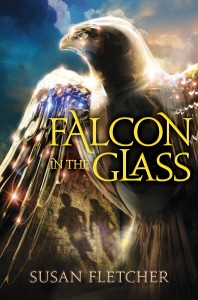The Falcon in the Glass by Susan Fletcher
 In Venice in 1487, the secrets of glassblowing are guarded jealously. Renzo, a twelve-year-old laborer in a glassworks, has just a few months to prepare for a test of his abilities, and no one to teach him. If he passes, he will qualify as a skilled glassblower. If he fails, he will be expelled from the glassworks. Becoming a glassblower is his murdered father’s dying wish for him, and the means of supporting his mother and sister. But Renzo desperately needs another pair of hands to help him turn the glass as he practices at night.
In Venice in 1487, the secrets of glassblowing are guarded jealously. Renzo, a twelve-year-old laborer in a glassworks, has just a few months to prepare for a test of his abilities, and no one to teach him. If he passes, he will qualify as a skilled glassblower. If he fails, he will be expelled from the glassworks. Becoming a glassblower is his murdered father’s dying wish for him, and the means of supporting his mother and sister. But Renzo desperately needs another pair of hands to help him turn the glass as he practices at night.
One night he is disturbed by a bird — a small falcon — that seems to belong to a girl hiding in the glassworks. Soon Renzo learns about her and others like her — the bird people, who can communicate with birds and are condemned as witches. He tries to get her to help him and discovers that she comes with baggage: ten hungry bird-kenning children who desperately need his aid. Caught between devotion to his family and his art and protecting a group of outcast children, Renzo struggles for a solution that will keep everyone safe in this atmospheric adventure.
Three things for the reader to like
1. I have always loved books that took me some place new and immersed me in that world and this one does it in spades. Not only do we get oodles of rich detail about Venice (one of my favorite places in the world) we also get a detailed look at the art and life of a glassblower–something I knew nothing about.
2. It seems that I often hear either plot or beautiful language praised as if these two things are mutually exclusive. Here is a counter example. There are lovely, though not over wrought, phrases on nearly every page. And there is a compelling plot, with twists and turns and murky bits, befitting the medieval canal town.
3. There is also plenty of insight into a boy trying to make it in a man’s world. I particularly liked the moment when Renzo broke into the carpentry shop of his mother’s suitor. He had great scorn for this man, but seeing how well the carpenter keeps his tools, Renzo has a new perspective and greater respect for him even though he is a member of a comparatively lowly profession. It’s a small moment in the overall story but a telling and insightful detail.
Something for the writer to think about
This book raises a perennial question for me. How magic does magic have to be? Some readers want everything clearly spelled out and others love the mystery that invites personal interpretation and mental embellishment. In this book, the “bird children” are able to communicate with birds telepathically. It’s a small but vital detail in the plot.
But the reason the kids can ken with birds is never stated. The mechanism by which they communicate is never spelled out in detail. I was curious about both things and a little bummed never to learn what I wanted to understand. It’s a fine book anyway and it got me thinking about how much needs to be said about magic in a story and how much can be left open.
How about you readers. How much do you want to know about the magic and how it works?

I don’t want things spelled out too much. I like a little bit left to my imagination. But it also has to make sense!
This book reminds me of The Thief Lord by Cornelia Funke, also set in Venice (but modern day) and Daughter of Venice by Donna Jo Napoli, one of her best, I think, which is set in 1592. I love reading books about Venice. Can you tell I love Venice? I was there once, in 1976, and I’ve never forgotten it. I’ll definitely be adding this book to my TBR list. Thanks, Rosanne!
I was there once, in 1976, and I’ve never forgotten it. I’ll definitely be adding this book to my TBR list. Thanks, Rosanne!
I was terribly ill when I visited Venice and traveling with a baby but even so I loved the city and the Venetians were so warm and kind to me and my daughter. I’ve always wanted to go back.
I think Susan just a super job of making it vivid and true not just to the history of how Venice was in the 1500s but how it was to the eye of a 13-year old aspiring glassblower which is much harder to do than she makes it look.